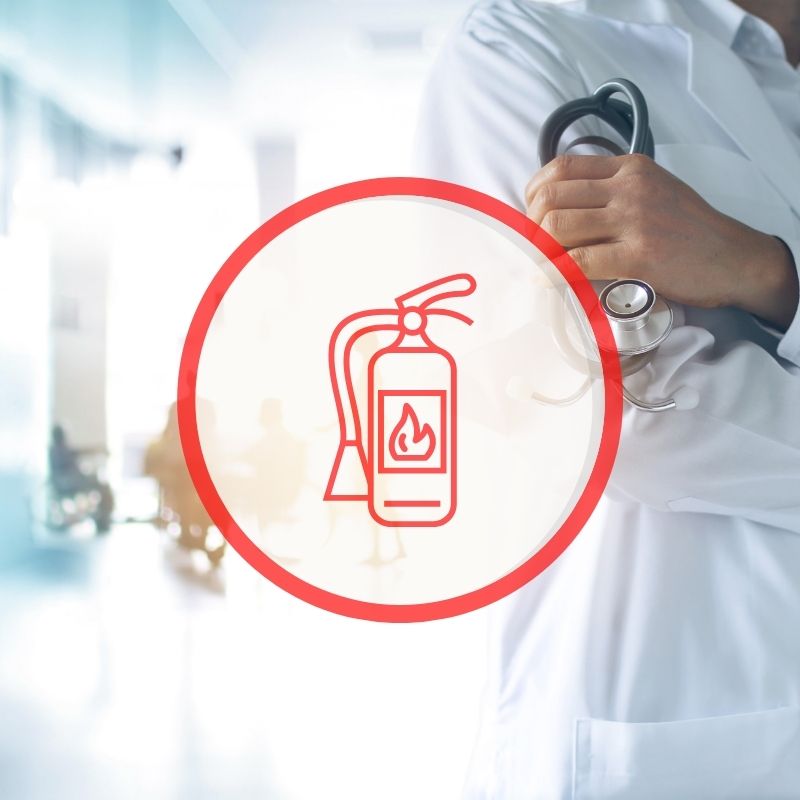
**This article was published on 8/5/2016 and updated on 11/15/2021
Protecting patients in hospitals and healthcare facilities is the top priority of healthcare staff. Protecting patients during a fire or life safety emergency poses unique challenges in the healthcare industry when patients are simply unable to evacuate.
Unique Challenges for Fire Safety in Hospitals
Hospitals usually consist of several buildings spread out over a large medical campus, with complex building layouts. Several activities may be occurring such as surgeries, medical imaging or tests which simply cannot be interrupted. Many patients are unable to evacuate on their own and staff may be unable to evacuate patients quickly. If an emergency does require an evacuation, it is extremely time-consuming and complex with many immobile patients.
Hospitals include patients admitted for longer stays and patients at the facility for outpatient procedures. Healthcare facilities includes doctors’ offices, ambulatory facilities, and long-term care facilities.
Code Requirements for Fire Safety in Healthcare
Security at hospitals requires an increased level of protection compared to other types of facilities with an integrated fire and life safety system. Most fire alarm requirements in healthcare relate directly to patient care with emergency procedures, while other requirements are directly related to the unique nature of critical care in large facilities. Early detection, adequate alerts, careful monitoring and quick response from staff and emergency personnel are essential in healthcare.
An integrated commercial security system provides the necessary safeguards to protect occupants and patients from fire, smoke, and gas as well as preventing unauthorized intruders from entering the facility. Hospitals and healthcare facilities must adhere to the same national fire and life safety codes as other organizations as well as meeting the requirements set forth by the Centers for Medicare and Medicaid (CMS).
You can learn more about the Life Safety Code & Health Care Facilities Code Requirements for Medicaid and Medicare providers from CMS.
NFPA Code Requirements for Healthcare Facilities
The CMS in conjunction with other accrediting organizations such as the National Fire Protection Association, NFPA, certify and accredit hospitals and healthcare facilities. Fire safety code requirements include:
NFPA 72: National Fire Alarm and Signaling Code
NFPA 99: Health Care Facilities Code
The CMS requires that healthcare facilities meet the 2012 editions of NFPA 99 and NFPA 101®. CMS works with various state agencies to assess healthcare facilities for compliance to the Life Safety Code requirements. State agencies can enter into contracts or sub-agreements with their State Fire Marshal or Authority Having Jurisdiction (AHJ) responsible for enforcing their state requirements to fire code safety.
Benefits of an Integrated Fire Protection System in Hospitals
An integrated fire and life safety system combines all elements of effective fire and smoke alarm detection with access control monitoring and physical security into one system.
Remote Monitoring and Control
Evacuation notification, lockdowns and emergency alerts can be managed and monitored from a single or numerous control points either on site or from remote monitoring locations.
Voice and LED Evacuation
Voice and LED evacuation directions combine with such elements as remote-control door locking, elevator control, closed circuit video and motion detection systems in fire or security emergencies. These may be beneficial in fire emergencies or threatening security events.
Integrated Access and Monitoring
Integrating card access control with closed circuit TV monitoring and motion detection, security personnel can track and monitor suspicious activity within the building or on the external property. Likewise, security personnel can instantly restrict access by locking all entry doors or initiating evacuation if a dangerous situation should arise within.
HRSS Offers Integrated Fire Safety Solutions for Healthcare
High Rise Security Systems, HRSS, is a fire and life safety system provider in the Chicagoland area with decades of expertise in protecting commercial properties. We offer fire and life safety system solutions to hospitals, healthcare facilities and many other commercial properties including hotels, schools, and businesses of all sizes.
Our fire safety specialists possess deep technical knowledge of all fire and life safety code requirements and help our clients to ensure total code compliance with a fire alarm system designed around your unique building layout and operations. We offer UL listed equipment from the leading fire alarm manufacturers in the world including NOTIFIER® by Honeywell. NOTIFIER® offers unique solutions for fire safety integration with innovative technology and first-to-market products like self-testing smoke alarm devices.
HRSS provides turnkey solutions with quality fire alarm equipment, full system design with AutoCAD and experienced system designers, fire alarm system testing, inspections, maintenance, repairs and monitoring 24/7/365. Contact us to learn more about code compliant fire and life safety security integration for healthcare facilities.



